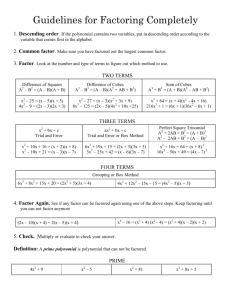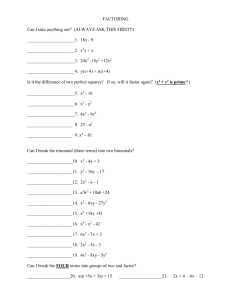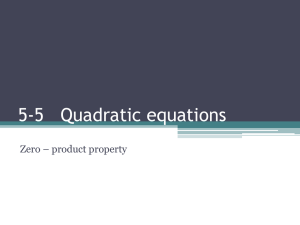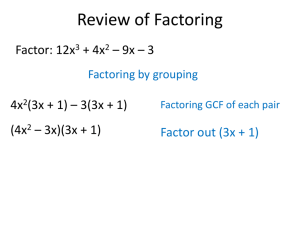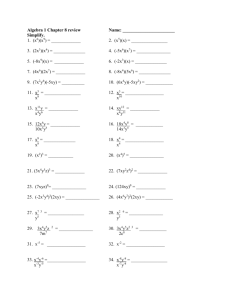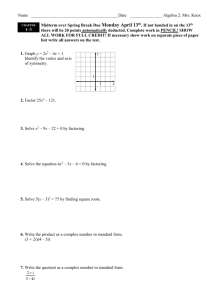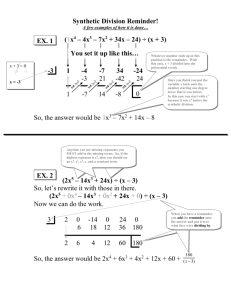Factoring and Special Products Worksheet
advertisement
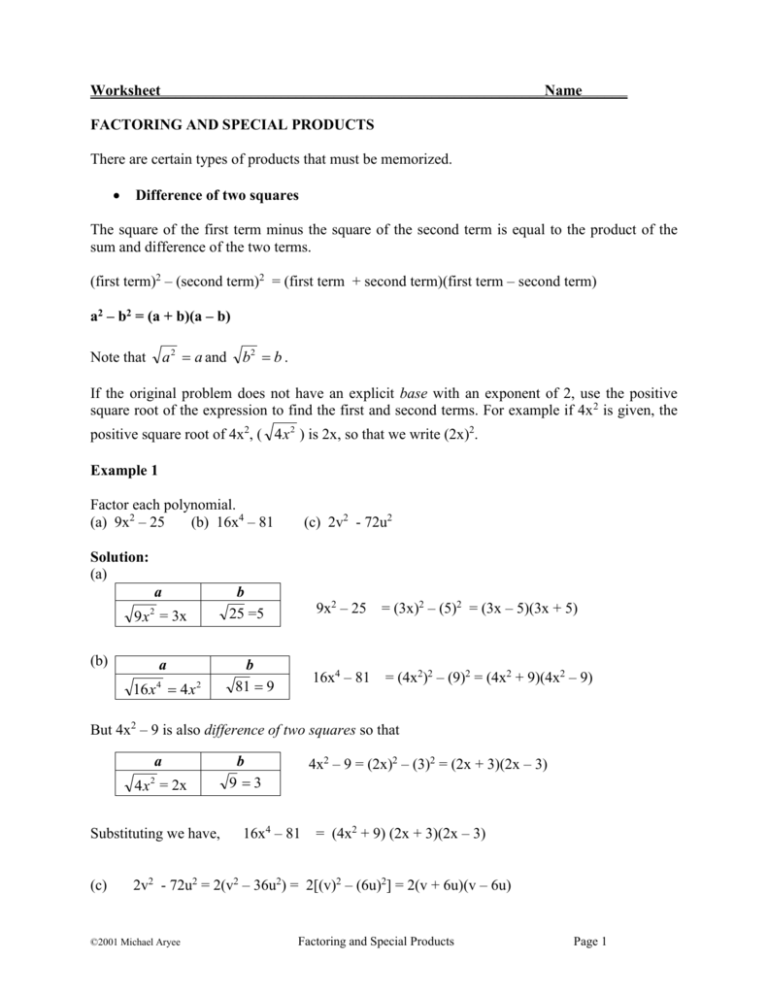
Worksheet___________________________________________________Name______ FACTORING AND SPECIAL PRODUCTS There are certain types of products that must be memorized. Difference of two squares The square of the first term minus the square of the second term is equal to the product of the sum and difference of the two terms. (first term)2 – (second term)2 = (first term + second term)(first term – second term) a2 – b2 = (a + b)(a – b) a 2 a and Note that b2 b . If the original problem does not have an explicit base with an exponent of 2, use the positive square root of the expression to find the first and second terms. For example if 4x 2 is given, the positive square root of 4x2, ( 4x 2 ) is 2x, so that we write (2x)2. Example 1 Factor each polynomial. (a) 9x2 – 25 (b) 16x4 – 81 (c) 2v2 - 72u2 Solution: (a) a b 25 =5 9x 2 = 3x (b) a 16 x 4 x 4 2 b 81 9 9x2 – 25 = (3x)2 – (5)2 = (3x – 5)(3x + 5) 16x4 – 81 = (4x2)2 – (9)2 = (4x2 + 9)(4x2 – 9) But 4x2 – 9 is also difference of two squares so that a 4x 2 = 2x Substituting we have, (c) 4x2 – 9 = (2x)2 – (3)2 = (2x + 3)(2x – 3) b 9 3 16x4 – 81 = (4x2 + 9) (2x + 3)(2x – 3) 2v2 - 72u2 = 2(v2 – 36u2) = 2[(v)2 – (6u)2] = 2(v + 6u)(v – 6u) ©2001 Michael Aryee Factoring and Special Products Page 1 Problem 1 a) x2 – 1 b) x2 – y2 c) 4x2 – y2 d) m4 –16 e) 9 – y6 f) 25x2 – 4a2 g) 100 – 49a6 h) s2 - 36 i) y2 – 49 j) 3a2 – 12x2 k) (2x + 3)2 – y2 l) (a+ b)2 – (a – b)2 m) x3 – x n) 3ax2 – 3ay2 o) 100a2 – 64b2 p) s64 –t22 q) a4 – b2 r) x4 – 4y4 s) 9x2 – 64y2 t) 2x2 – 2y2 u) 44x4 – 99y4 v) 3a3 – 12a w) a4 – b4 x) 16y12 – 1 ©2001 Michael Aryee Factoring and Special Products Page 2 Factoring perfect squares If the middle term of a trinomial is equal to twice the product of the positive square root of the first term and the last terms, then that trinomial is a perfect square, and it is equal to the square of the sum or difference of the positive square root of the first and last terms. a2 + 2ab + b2 = (a + b)2 a2 - 2ab + b2 = (a - b)2 Note that middle term = twice the product of a 2 a and b2 b = 2ab. Example Factor each polynomial. (a) x2 – 10x + 25 (b) 16x2 + 24x + 9 Solution: (a) x 2 x and 25 = 5 so that, middle term = 2(x)(5) = 10x this match with the middle term of the original problem. x2 – 10x + 25 = (x – 5)2 (b) 16x2 4 x and 9 3 so that, middle term = 2(4x)(3) = 24x this match with the middle term of the original problem. 16x2 + 24x + 9 = (4x + 3)2 Problem Factor each polynomial. a) 9x2 – 30xy + 25y2 b) 4x2 + 36x + 81 c) d) 16x2 – 40xy + 25y2 e) 16x2 + 56x + 49 f) x2 + 18x + 81 ©2001 Michael Aryee Factoring and Special Products x2 + 24x + 144 Page 3 Sum and Difference of two cubes The sum of two cubes is expressed as a3 + b3 = (first term)3 + (second term)3 Sum of two cubes = [first term + second term][(first term)2 – (first term)(second term) + (second term)2] In general, a3 + b3 = (a + b)(a2 – ab + b2) The difference of two cubes is expressed as a3 - b3 = (first term)3 - (second term)3 Difference of two cubes = [first term - second term][(first term)2 + (first term)(second term) + (second term)2] In general, a3 - b3 = (a - b)(a2 + ab + b2) Note that 3 a3 a and 3 b3 b . If the original problem does not have an explicit base with an exponent of 3, use the cube root of the expression to find the first and second terms. For example if 8x3 is given, the cube root of 8x3, ( 3 8x3 ) is 2x, so that we write (2x)3. Example Factor each polynomial. (a) 8x3 – 27 (b) 64x6 + 1 Solution: (a) 3 3 8x = 2x, and 3 27 3 so that, a 2x b 3 a2 (2x)2 = 4x2 ab (2x)(3) = 6x b2 (3)2 = 9 8x3 – 27 = (2x)3 – (3)3 = (2x – 3)[(2x)2 + (2x)(3) + (3)2] = (2x – 3)(4x2 + 6x + 9) (b) 3 64 x6 4 x2 , and 3 1 1 so that, 64x6 + 1 a 4x2 b 1 a2 (4x2)2 = 16x4 ab 2 (4x )(1) = 4x2 = (4x2)3 + (1)3 = (4x2 + 1)[(4x2)2 - (4x2)(1) + (1)2] = (4x2 + 1)(16x4 - 4x2 + 1) ©2001 Michael Aryee Factoring and Special Products Page 4 b2 (1)2 = 1 Problem 2 a b a2 b2 ab Factor each polynomial with the aid of this chart. a) x3 – 1 b) x3 + y3 c) 27x3 – y3 d) m3 – 216 e) 27 – y3 f) 125x3 + 8a3 g) 1000 + 27a3 h) s3 - 64 i) y3 + 125 j) 3a3 – 81x2 k) (2x + 3)3 – y3 l) r3 + 8b3 m) x4 + x n) 3ax3 – 3ay3 o) 54a3 – 128b3 p) s6 – t3 q) 128a3 – 2b3 r) x3 + 64y6 s) 81x3 + 64y3 t) 2x3 – 2y3 u) 81x3 – 3y3 ©2001 Michael Aryee Factoring and Special Products Page 5
